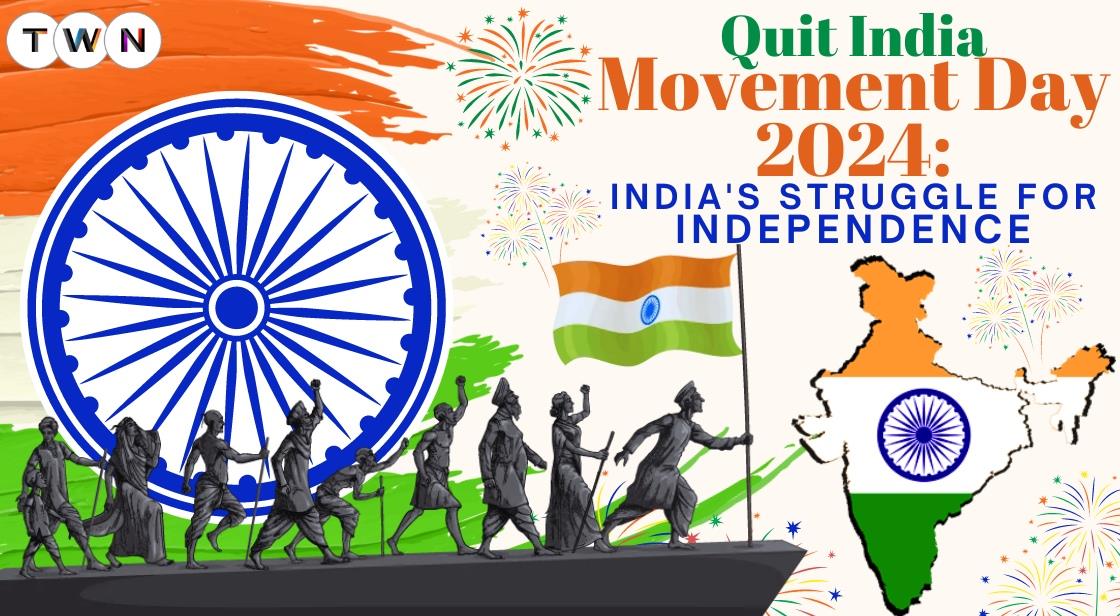Quit India Movement Day 2024: India's Struggle for Independence

Blog Post
Quit India Movement Day, observed on August 9th each year, commemorates a pivotal chapter in India’s struggle for independence from British colonial rule. This year, as we mark the 82nd anniversary of this historic event, we reflect on the profound impact of the Quit India Movement, which was launched on August 9, 1942, with Mahatma Gandhi's iconic "Do or Die" call.
This movement was not merely a political protest but a significant mass uprising that underscored the deep yearning for freedom among Indians.
The immediate catalyst for the Quit India Movement was the failure of the Cripps Mission in early 1942. This British proposal for India’s post-war political status fell short of the Indian National Congress’s demands for complete independence, intensifying frustrations.
The All India Congress Committee's resolution, adopted on August 8, 1942, demanded the immediate withdrawal of British forces, marking a pivotal shift from seeking dominion status to calling for outright freedom.
The British response to the movement was severe, involving mass arrests and violent repression. Leaders like Gandhi and Nehru were imprisoned, and many activists faced brutal treatment. Despite this, the movement became a powerful symbol of India’s unified resistance against colonial rule, inspiring further momentum toward independence.
Today, Quit India Movement Day stands as a powerful reminder of the sacrifices made by freedom fighters and the resilience of the Indian spirit.
It reaffirms our commitment to the values of democracy and justice, and serves as a poignant occasion to celebrate the unity and strength that led India toward its liberation.
#MahatmaGandhi
#QuitIndiaMovement
#IndianFreedomStruggle
#AzadiKaAmritMahotsav
#IndianIndependenceMovement
Quit India Movement Day: A Resurgence of Patriotism
The Birth of Quit India Movement: The Quit India Resolution
The Quit India Movement, a pivotal chapter in India's struggle for independence, emerged as a culmination of growing disillusionment with British rule. The movement was officially launched on August 8, 1942, at a session of the All-India Congress Committee in Bombay (now Mumbai).
The Precursor: The Cripps Mission
The immediate catalyst for the Quit India Movement was the failure of the Cripps Mission. Sent by the British government in 1942, the mission aimed to secure India's cooperation in the Second World War in exchange for promises of dominion status after the conflict. However, the proposed terms were unacceptable to the Indian National Congress, as they fell short of demanding complete independence. The rejection of the Cripps Mission deepened the sense of betrayal and disillusionment among Indians.
The Call for Independence
In response to the failure of the Cripps Mission, the Congress Working Committee passed the Quit India Resolution on August 8, 1942. This landmark decision marked a decisive shift in the Congress's strategy, from seeking dominion status to demanding the immediate and unconditional withdrawal of British rule from India.
Mahatma Gandhi, the undisputed leader of the Indian National Congress, delivered a powerful speech at the Gowalia Tank Maidan in Mumbai, where he gave the clarion call of "Do or Die." This slogan encapsulated the spirit of the movement, urging Indians to fight for freedom with unwavering determination.
The Quit India Movement was not merely a political decision but a reflection of the deep-seated desire for self-determination among the Indian people. The British Raj had become increasingly oppressive, with economic exploitation, political subjugation, and social injustices fueling resentment. The movement provided an outlet for this pent-up frustration and ignited a spark of hope for a free India.
A Call to Action
The movement was ignited by Mahatma Gandhi's clarion call for "Do or Die." This rallying cry resonated deeply with the Indian masses, inspiring them to rise against British colonial rule. The Congress Working Committee's resolution demanding the immediate end of British rule provided the impetus for a nationwide uprising.
A Broad Spectrum of Participation
The Quit India Movement was a truly mass movement, drawing support from diverse sections of society. Students, workers, farmers, and women played pivotal roles in the struggle. Their collective determination and courage challenged the foundations of British imperial power.
-
Students: Youthful exuberance and idealism fueled student participation. They organized protests, boycotts, and strikes, demonstrating a fearless commitment to the cause of independence.
-
Workers: Industrial workers joined the movement in large numbers, halting production and disrupting the British war economy. Their strikes and demonstrations paralyzed key sectors, weakening the colonial regime.
-
Peasants and Farmers: Rural India rose in support of the Quit India Movement. They participated in land agitations, refused to pay taxes, and disrupted colonial administrative structures.
-
Women: Women played a crucial role in the movement, stepping out of their traditional roles to actively participate in protests and demonstrations. Their courage and determination inspired the nation.
The Spirit of Sacrifice
The Quit India Movement was marked by unparalleled sacrifices. Countless individuals were arrested, imprisoned, and tortured for their involvement. Many lost their lives in the struggle for freedom. Yet, the spirit of resistance remained unbroken.
The movement also witnessed acts of extraordinary bravery and resilience. Ordinary citizens transformed into fearless freedom fighters, challenging the might of the British empire. Their courage and determination have become an enduring legacy.
A Turning Point
While the Quit India Movement did not immediately lead to independence, it marked a decisive turning point in India's struggle. It demonstrated the unwavering resolve of the Indian people and weakened the British hold on the country. The movement also garnered international support for India's cause, paving the way for eventual freedom.
The legacy of the Quit India Movement continues to inspire generations. It serves as a reminder of the sacrifices made by our forefathers and the importance of unity, courage, and perseverance in the face of adversity.
The spirit of the Quit India Movement remains relevant today, urging us to strive for a just and equitable society, where the rights and aspirations of every citizen are upheld.
Also Read: Buddhism and the Path to Global Peace: A War-Free World
The Spark of Rebellion: The Quit India Resolution
The Quit India Movement, a pivotal chapter in India's struggle for independence, was ignited by the All India Congress Committee (AICC) on August 8, 1942. The culmination of years of growing discontent and resistance against British colonial rule, the movement was a direct challenge to imperial authority.
The AICC Resolution
The AICC, under the leadership of Mahatma Gandhi, passed a historic resolution demanding the immediate and complete withdrawal of British rule from India. This bold declaration marked a decisive shift in the Congress's strategy, from seeking dominion status to demanding outright independence. The resolution was a powerful expression of the Indian people's determination to break free from colonial shackles.
Mahatma Gandhi's "Do or Die" call
Mahatma Gandhi's subsequent call for "Do or Die" electrified the nation. His words resonated with millions, inspiring a sense of urgency and purpose. Gandhi's charismatic leadership, combined with his unwavering commitment to nonviolent resistance, galvanized the masses and transformed the Quit India Movement into a truly popular uprising.
The Psychology of Rebellion
The British Raj, despite its might, had become increasingly unpopular due to its exploitative policies, economic hardships, and disregard for Indian aspirations. The Quit India Movement tapped into this growing discontent, providing a platform for people to express their anger and frustration. The movement's emphasis on nonviolence appealed to the conscience of the nation and presented a moral challenge to the British.
The call for "Do or Die" was more than just a slogan; it was a clarion call to action. It inspired a sense of sacrifice and selflessness among the Indian people, as they were prepared to give up everything, including their lives, for the cause of freedom.
The British Counteroffensive: A Brutal Response
The British government reacted to the Quit India Movement with swift and brutal repression. The arrest of Mahatma Gandhi and other prominent Congress leaders marked the beginning of a systematic crackdown on the movement.
Mass Arrests and Imprisonment
The British authorities unleashed a wave of mass arrests, targeting not only the leadership but also ordinary citizens who were actively participating in the movement. Countless individuals were imprisoned without trial, subjected to harsh conditions, and often subjected to torture and abuse.
Suppression of Dissent
The British colonial administration employed a range of tactics to suppress the movement. Censorship was imposed on the press, restricting the flow of information and stifling public opinion. Curfews and other restrictive measures were imposed to curtail freedom of movement and assembly. The use of force, including the military, was not uncommon to quell protests and demonstrations.
Underground Resistance
Despite the brutal crackdown, the spirit of resistance remained unbroken. The Quit India Movement went underground, with clandestine networks emerging to carry on the struggle. These underground resistance groups continued to organize protests, sabotage British installations, and spread awareness about the movement.
The Indomitable Human Spirit
The British counteroffensive failed to crush the spirit of the Indian people. The movement, while suppressed on the surface, continued to simmer beneath, fueled by the sacrifices of countless individuals. These underground activists, often working in obscurity, kept the flame of freedom alive, inspiring hope and resistance among the masses.
The British, despite their efforts, found it increasingly difficult to control the situation. The Quit India Movement had exposed the vulnerabilities of the colonial regime and demonstrated the strength of the Indian people's resolve for independence.
Legacy of the Quit India Movement
The Quit India Movement left an enduring legacy that continues to shape India's identity. It was more than just a political uprising; it was a profound transformation of the national consciousness.
A Catalyst for Unity
Perhaps the most significant legacy of the movement is the fostering of national unity. By bringing together people from diverse backgrounds and regions, the Quit India Movement forged a shared sense of purpose and identity. It transcended religious, linguistic, and caste divisions, creating a powerful collective will to achieve freedom.
The Spirit of Sacrifice
The movement was characterized by a spirit of selfless sacrifice. Countless individuals, both known and unknown, laid down their lives for the cause of independence. Their courage and determination became a beacon of inspiration for generations to come.
A Catalyst for Social Change
The Quit India Movement was not merely a political struggle; it was also a social revolution. It challenged the status quo and inspired movements for social reform. The movement empowered women, youth, and marginalized communities, giving them a voice in shaping the nation's future.
Global Impact of Quit India Movement
The Quit India Movement resonated with freedom struggles worldwide. It demonstrated the power of nonviolent resistance as a potent tool for achieving political change. India's struggle inspired anti-colonial movements in Africa, Asia, and other parts of the world.
The Enduring Idealism
The Quit India Movement instilled a deep-rooted sense of idealism and patriotism among the Indian people. The values of freedom, democracy, and secularism, which were at the core of the movement, continue to shape the nation's aspirations.
A Call to Action
On Quit India Movement Day, we commemorate the sacrifices of our freedom fighters and reaffirm our commitment to the ideals they cherished. The movement's legacy challenges us to strive for a just and equitable society, where the rights and dignity of every citizen are upheld.
By remembering the past, we can inspire future generations to carry forward the torch of freedom and work towards building a stronger, more inclusive India.
Frequently Asked Questions About Quit India Movement Day
What is Quit India Movement Day?
Quit India Movement Day commemorates the launch of the Quit India Movement, a pivotal chapter in India's struggle for independence from British colonial rule. It is a day to remember and honor the sacrifices made by countless Indians in their pursuit of freedom.
When is Quit India Movement Day celebrated?
Quit India Movement Day is observed annually on August 9th, marking the anniversary of the launch of the movement in 1942.
What was the Quit India Movement?
The Quit India Movement, also known as the August Kranti, was a mass civil disobedience movement launched by Mahatma Gandhi on August 9, 1942. It aimed to secure India's complete independence from British rule. The movement was characterized by widespread protests, strikes, and acts of civil disobedience, demonstrating the Indian people's unwavering determination to achieve freedom.
What was Mahatma Gandhi's role in the Quit India Movement?
Mahatma Gandhi was the driving force behind the Quit India Movement. His iconic "Do or Die" call inspired millions of Indians to participate in the struggle for independence. His leadership and unwavering commitment to nonviolence made him a symbol of India's resistance against British rule.
Why is Quit India Movement Day significant?
Quit India Movement Day is significant as it commemorates a pivotal moment in India's history. The movement showcased the unity and determination of the Indian people in their fight for freedom. It serves as a reminder of the sacrifices made by countless individuals and inspires us to uphold the values of democracy, freedom, and justice.
Conclusion
Quit India Movement Day serves as a profound reminder of the unwavering resolve and sacrifices made by countless individuals in India's quest for independence. Observed annually on August 9th, this day commemorates the landmark moment in 1942 when Mahatma Gandhi’s "Do or Die" call galvanized millions in a united struggle against British colonial rule. Although the Quit India Movement did not immediately bring about independence, it marked a decisive turning point that intensified the fight for freedom and showcased the indomitable spirit of the Indian people.
The legacy of the Quit India Movement is woven into the fabric of modern India, inspiring future generations to uphold the values of freedom, democracy, and justice. As we reflect on this historic struggle, it is crucial to honor the sacrifices of those who fought for our nation’s liberation and to remain committed to the ideals they championed. Quit India Movement Day not only celebrates the achievements of the past but also challenges us to build upon those ideals, striving for a just, equitable, and inclusive society. By remembering our history, we rekindle the spirit of patriotism and reaffirm our dedication to the enduring quest for a better and brighter future for India.
You May Like
EDITOR’S CHOICE












